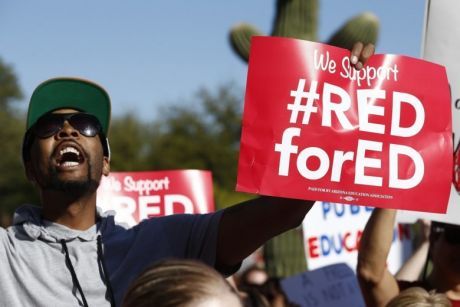Features
You are here
Teachers Rising!

April 24, 2018
The West Virginia teachers’ strike has ignited a wave of mass resistance among US teachers. West Virginia teachers defied the state government and their union leadership to initiate a historic strike on February 22 to demand better wages and protect their benefits. And they won!
Strikes and walk-outs have exposed the horrendous working conditions of teachers many who work multiple jobs to make ends meet and use food banks to get by. Also exposed is the deterioration of public schools: mould, broken toilets, obsolete and wrecked textbooks and lack of basic supplies, like pencils, that teachers must provide. Years of concessions and erosions of their working conditions and erosion of resources for students pushed these teachers to the brink. They said enough is enough.
Their success and the victory of their strike lit a flame that is quickly spreading through the US. In less than two months, teachers in mainly Republican Party controlled “red states” and right-to-work states like West Virginia are building mass protests. In Arizona, Oklahoma, Kentucky and now Colorado teachers have struck, walked-in or walked out to demand better working conditions for themselves and better learning conditions for their students.
West Virginia: miners’ strike to teachers’ strike
In West Virginia, teachers are taking inspiration from the history of struggles of miners in West Virginia coalfields in the early 20th century. Small walkouts began in early February, organized by the sons and daughters of coal miners who had stood on the picket lines themselves. “When I was in diapers, my father was involved in a mine strike,” Justin Endicott, 34, a fourth-grade teacher in Mingo County, WV said.
“It was definitely bottom-up, not top-down,” according Jay O’Neal, who started the Facebook group that became a hub for organizing the early actions. “The unions soon jumped on board, and the strike was born.”
Oklahoma: nine day strike
Oklahoma teachers declared victory after a nine-day strike in April. The walkout prompted legislators to boost education funding by $479 million and up teachers' pay by an average of $6,100, the largest pay raise in state history. The teachers also won pay raises for support staff such as cafeteria workers and bus drivers, and secured $70 million in recurring revenue for classroom supplies.
Teachers flooded the state capital and went door knocking at the state legislators’ offices to demand that they not only fund wages but also restore millions that has been cut from education. On April 16, the day that Oklahoma teachers finished striking and went back to class, Colorado teachers walked out.
Arizona: Red for Ed
In Arizona, where teachers’ pay is the lowest of any US state, Arizona Educators United (AEU), a coalition of teachers, support staff and administrators initiated a #RedforEd campaign. Their demands are for better pay for all school staff—support and teachers but they are also demanding increased per pupil funding.
Arizona teachers voted on April 19 to strike following weeks of “walk-ins” protests. Teachers here, following the lead of Oklahoma teachers, are raising the stakes with demands that are not just about their working conditions. Dylan Wegela, an AEU leader said, “I can’t walk back into my classroom without getting more for my students and this movement.”
West Virginia to Montreal
In the US, Canada, the UK and Brazil teachers are also on the front line of resistance to austerity. Ontario college faculty in OPSEU were on strike for 5 weeks in the fall 2017. Carleton University faculty were on strike to defend pensions and York University contract faculty and teaching assistants remain on a protracted strike for job security.
UK university faculty defied their union leadership to stay on strike to defend pensions. Teachers in Sao Paulo faced brutal police violence striking against cuts to benefits.
Montreal teachers have called for a May Day strike on May 1. Teachers voted for this “illegal” strike against the wishes of their trade union leaders.
Red-state revolt
It is notable that these mass protests and strikes are happening in mainly Republican-controlled red states, that overwhelming voted for Trump.
“Those who voted for Trump may have wanted to shake up the system, but there’s a lot of other people that want to shake up unfairness,” said Randi Weingarten, president of the American Federation of Teachers. “You saw that in the women’s marches, you see that in the 'Me Too' movement, you see that in the kids in Parkland, who rallied for stricter gun controls.”’
Similarly, the usual right-wing talking points saying teachers are greedy and don’t care about their students is backfiring. In all of these struggles, students and parents have been up front showing their support for their striking teachers.
The disconnect of the Trump government was on display when Betsy DeVos, Secretary of Education, admitted she had no idea what the conditions of public school are in her home state, Michigan. She has been pushing the Trump government’s continuation of the privatization of public school through charters and vouchers as “choice” in education.
Power in the Streets
This movement is exposing the Trump Republicans’ real agenda, and the teachers’ union leaders—who have now jumped in front of the grassroots struggles—are saying that the way to solve this is to vote the Democrats in. But it was the Obama Democrats who accelerated the erosion and privatization of education after the 2008 crisis.
The labour leaders’ call for leaving the streets for the ballot box was a disaster in Wisconsin when public sector workers took over the capitol in 2011. Channelling that anger into an election returned anti-union Governor Scott Walker and he proceeded to decimate union power.
What this resistance proves that it is the protests and strikes that masses of people are participating in that is getting the job done of forcing governments to refund education and stop the cuts and austerity.
Register now for “Join the Resistance: Marxism 2018,” a two-day conference April 27-28 in Toronto, including the session “Workers Rising,” “9 Hour Movement to the Fight for $15,” and “The Changing Working Class.”
Section:










